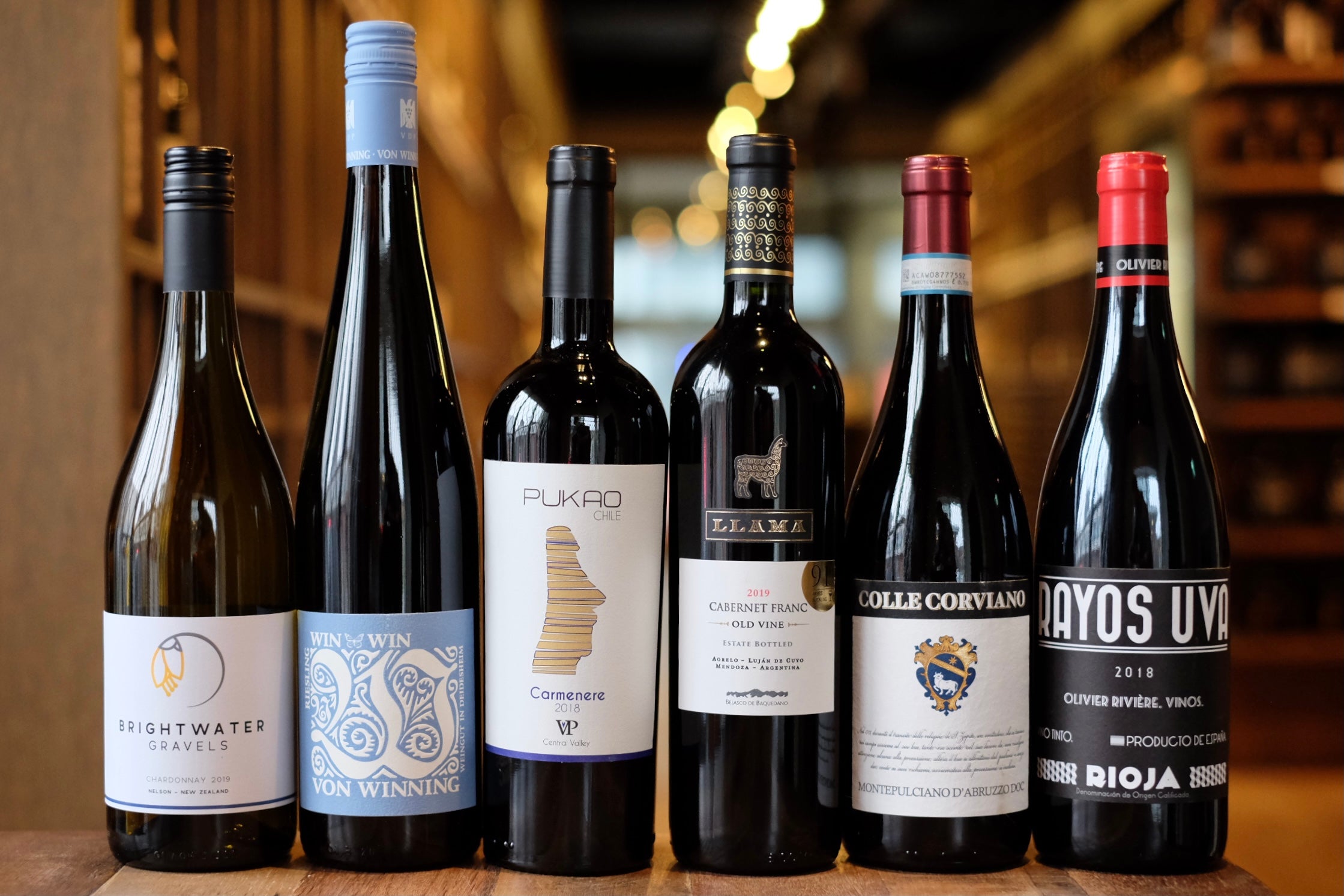| Hello everyone! It's the start of a new month and we're back with a new edition of Vine Arts Wine Club! Your wine bags will be available for pickup on Monday, November 1st. For this months selections we've picked six wines from six countries - New Zealand, Germany, Chile, Argentina, Italy, and Spain. We hope you enjoy them! Cheers! |
| 2019 Brightwater Gravels Chardonnay Nelson, New Zealand $27.69 | Where The small New Zealand estate of Brightwater Gravels is located where the Wai-iti and the Wairoa rivers meet, in the region of Nelson. Situated at the northern end of the South Island, this wine appellation is not as famous as neighbouring Marlborough. Surrounded by mountains on three sides, Nelson is cut off with a distinct microclimate. Long and sunny summers are moderated by the nearby Tasman Sea, which offers cooling breezes. Warm days are followed by reliably cool nights, contributing significant diurnal temperature variation in the vineyards. Poor alluvial soils push the vines to work hard to survive, resulting in quality grapes. Nelson accounts for a tiny fraction of New Zealand’s total vineyards - only 2%. What Nelson’s cool climate is ideal for growing aromatic grapes. Varieties like Riesling, Pinot Gris, and unsurprisingly, Sauvignon Blanc, are widely farmed. Chardonnay accounts for about 15% of all the vines in Nelson. The most common red grape variety grown is Pinot Noir. You hear a lot about the different types of grape varieties out there, but you rarely hear about the particular clones being grown. Grape clones are cuttings taken from a single vine that have identical genetic material to their parent source. Having a particular clone can be helpful when a grower is looking for certain traits, such as berry size or the ability to retain acidity. In the case of the Brightwater Gravels Chardonnay, the clone is ‘Mendoza’. This clone is known for loose grape bunches, berries of different sizes, and the ability to make complex wines. ‘Mendoza’ was particularly popular with early grape growers in California. In making this wine, the winemaking team at Brightwater Gravels chose to highlight the clones' clear citrus character. Only the slightest touch of oak influence was used to introduce a touch of spice. Who The Brightwater Gravels winery has been owned and operated by the same family for three generations. It was started by Rob Grey, who moved to the town of Southland. The estate was initially purchased to be operated as a dairy farm. Involved in the dairy industry until 1996, Rob decided to switch his focus to viticulture. Planting the estate to grapevines, he started out by selling his grapes to larger wineries such as Kim Crawford and Craggy Range. In 2011 Rob’s daughter Kylie and her husband Ryan O’Connell moved back to Brightwater. Collaborating with Rob, the couple officially launched Brightwater Gravels. Today the vines are farmed according to sustainable principles and are planted to a mix of Pinot Gris, Sauvignon Blanc, Chardonnay, and Pinot Noir. In the cellar, winemaker Trudy Shield (formerly of Waimea Estates) runs the show. Taste Elegant and inviting, the Brightwater Gravels Chardonnay is restrained and fruit forward. Pale yellow in colour, the nose has primary aromas of gala apple, citrus peel, hazelnut, and baking spice. The palate is medium bodied with creamy texture, crisp acidity and flinty minerality. The finish is dry and refreshing. A wonderful pairing for fish and chips. |
| 2020 Von Winning Win Win Riesling Pfalz, Germany $28.28 | Where Known as Palatinate in English, Pfalz is one of Germany’s most significant wine regions. With 23,500 hectares planted to the vine, it’s second only to the nearby Rheinhessen in scale. In addition, it’s the second sunniest region in the country behind Baden. Summers here are warm and temperate. Alsace’s doppelganger, it lies just on the opposite side of the border with France. Much like Alsace, Pfalz lies in a rain-shadow caused by the Haardt Mountains (an extension of France's Vosges Mountains). Sandwiched between the mountains and the Rhine River, the Deutsche Weinstrasse (German Wine Route) brings hordes of visitors to this beautiful region. September’s Wurstmarkt in Bad Dürkheim, one of the world's largest wine festivals, pulls in significant crowds exceeding 60,000 people. What 60% of the wine made in Pfalz is white. Of this, Riesling accounts for one in four bottles. In fact, the Pfalz produces so much Riesling that as of 2008, it was the largest Riesling grower in the world! Compared to the wines of neighbouring regions, Pfalz Riesling is notable for being richer and riper in character. In the past the wines were sweeter in style, where today dry styles have become more common. The Win Win Riesling is made from grapes harvested from single vineyards including Reiterpfad, Kalkofen and Kieselberg. These sites have a mixture of red sandstone and limestone soils. The most accessible wine made by Von Winning, the wine was vinified in a combination of 50% large oak barrels and 50% stainless steel tanks. Who Created in 1849 by Dr. Andreas Deinhard, Weingut Von Winning is one of Germany’s oldest wineries. The estate owes much of its success to Leopold von Winning, who in the early 1900’s dedicated his life to crafting high quality wines. Leopold, a founding member of VDP, an association of German premium wineries, treated his vineyards with the utmost care. Under Leopold’s tenure Von Winning became one of Germany's top wineries. Following his death the winery was purchased by the Hoch family and the name changed to "Dr. Deinhard". With the arrival of late-owner Achim Niederberger and winemaker Stephan Attman in 2007, Weingut Von Winning was revived. The 40 hectares of high density vineyards are farmed sustainably, and in the winery the grapes are vinfied naturally without artificial cooling. Bottled with minimum handling and without filtration, the wines of Von Winning offer striking minerality and balanced Pfalz richness. Taste Von Winning's most accessible wine, the Win Win Riesling offers fantastic complexity for the price point. Light golden straw in colour, on the nose it exhibits zestful aromas of fresh squeezed limes, candied orange, pineapple, and flint. On the palate there is a combination of ripe citrus flavours and high octane acidity. The finish is dry with sturdy minerality. Serve it with decadent Choucroute Garnie à l'Alsacienne (Alsatian braised sauerkraut with mixed meats and sausages). |
| 2018 Pagnel Pukao Carménère Curicó Valley, Chile $20.77 | Where The Curicó Valley is located in the central part of Chile, about 185 kilometres south of the capital of Santiago. Situated between the Pacific Ocean and the Andes, the eastern and western sections of the region are mountainous and separated by a fertile central valley. Like much of Chile, the Andes mountain range plays a large role in the prevailing Mediterranean style climate. Cool winds funneled down from the mountains provide natural air-conditioning in the vineyards, and snow melt provides much needed water. Closer to the ocean, the Coastal Ranges dissipate acute maritime influences. The region's soils are slightly more fertile than in many other wine regions of Chile, consisting mostly of limestone and volcanic rock from the Andes. What Although planted to vine as early as the mid 1800’s, the present-day wine industry of the Curicó Valley didn’t begin to form until the 1970’s. The establishment of some well respected wineries, who introduced modern winemaking technologies, did much to elevate the quality of Curicó’s wines. Grape growers can proudly boast that there are vines in the region that exceed 100 years old! Today the Curicó Valley is best known as a source for reliable wines made mostly from Cabernet Sauvignon, Chardonnay and Sauvignon Blanc. This wine from Pagnel Wines is made from one of the other main Bordelais grape varieties: Carménère. Well adapted to Chile’s growing conditions, this late-ripening grape was long misidentified as Merlot by grape growers. It is now one of the country’s favourite grape varieties. Who Pagnel wines was established by two friends, Sebastian Paganelli and Rodrigo Concha, who wanted to produce exceptional wines from small family vineyards. Many of the grape growers they knew were struggling to be economically viable because of their small scale. By offering fair compensation for the grapes and encouraging sustainable farming practices, Sebastian and Rodrigo were able to support these small farmers and help them succeed. They work very closely with the growers to ensure that the grapes harvested meet their exacting standards. Dealing with vineyards in the Curicó Valley, their primary relationships are with growers in the Sagrada Familia Valley in the western part of the region. Rodrigo handles the winemaking and is also the primary communicator with the grape growers. His approach in the cellar is restrained, with soft extractions and judicious use of ageing in French oak barrels. Taste The Pagnel Pukao Carménère is a juicy and ripe red wine, superb for everyday drinking. Deep ruby red in colour, it has luscious aromas of black plums, black raspberries, capsicum, tobacco, and vanilla. The palate is medium bodied with spicy blackfruit flavours, smooth tannins, and a dark chocolate finish. A delicious wine, especially given the great price. Pair it with cracked peppercorn crusted burgers or other spicy barbecued meats. |
| 2019 Belasco De Baquedano Llama Cabernet Franc Lujan de Cuyo, Argentina $21.76 | Where The Llama Cabernet Franc is made from grapes harvested from the Alto Agrelo district of Lujan de Cuyo. Located 35 kilometers south of the city of Mendoza in western Argentina, Agrelo is home to some of the country’s most famous wineries. Highly respected by winemakers around the world, this area has been dubbed “The Golden Mile” of Mendoza. Named after the village of Agrelo, the region sits in the western foothills of the Andes mountains. The vineyards here can reach as high as 1000 meters above sea level! At this height the sunlight is more intense and the nights can get very cool. Positioned in a rainshadow, the arid climate is extremely dry. The combination of altitude, pronounced sunshine, and strong diurnal temperature variation, has pronounced effects on grape growing in Agrelo. What As is the case with the rest of Mendoza, the dominant grape variety in Agrelo is Malbec, accounting for nearly half of all the region's wines. A minnow comparatively, Cabernet Franc accounts for only 4% of all wine made in the appellation. Originally from France, this grape variety has found a distinct expression in Argentina's high elevation vineyards. Compared with the Cabernet Franc based red wines of the Chinon or Saumur, the Cabernet Franc’s of Lujan de Cuyo are more broadly structured, with lush flavours and rich spiciness. The Llama Cabernet Franc is made from grapes harvested from old vines up to 50 years in age. A short maturation of 6 months was in French oak barrels. Who Belasco De Baquedano is helmed by Mikel Belasco Jauregui, who purchased the estate in the early 2000’s. The family have also owned a winery in the Spanish region of Navarre for 40 years. In the 1990’s Mikel’s father Juan Ignacio became interested in Malbec and enlisted the support of former Mouton Rothschild head winemaker Bertrand Bourdil. Together they scoured Argentina for a decade in search of exceptional vineyards. Eventually they discovered 90 hectares of vines that were owned by a family who sold the grapes to the surrounding wineries in Lujan de Cuyo. In 2003 they were able to purchase an adjacent vineyard of coveted centenary vines and built a large, modern multi-level winery. Today the winemaking team is led by winemaker Elizabeth Bordin, who is assisted by famed winemaking consultant Michel Rolland. Taste Bright scarlet red in colour, the Llama Cabernet Franc has a bouquet of ripe blackberries, stewed strawberries, black cherries, dark chocolate mole and roasted jalapeño. Round and layered, the palate is full bodied with sweet tannins and a spicy finish. This wine's herbal and spicy character make it an excellent match for Choripán. This delicious Argentine street food classic sandwich is served with spicy chorizo with chimichurri sauce on crusty French bread. |
| 2019 Colle Corviano Montepulciano d’Abruzzo Abruzzo, Italy $18.91 | Where The Italian region of Abruzzo is one of the greenest areas in Europe. Wedged between the Apennine mountains and the Adriatic sea, over a third of the zone is dedicated to national parks and natural reserves. One of the Italian peninsula’s highest peaks, Gran Sasso, looms large over rugged foothills and valleys. Isolated and difficult to access in parts, it is the ideal landscape for growing grape vines, which total around 36,000 hectares. The climate is defined by abundant sunshine and bountiful rainfall. The wide variation in vineyard elevations increases the number of micro-climates, further impacting Abruzzo’s dynamic and heterogeneous wine styles. What Although most often associated with Abruzzo, Montepulciano is widely planted across central Italy. Winemakers favour the variety for its soft tannins, low acidity, and affinited for oak ageing. Often made in an accessible, approachable style, it can also age magnificently when handled correctly. Montepulciano is also good when it comes to sharing the spotlight, making it a wonderful partner for blending (it’s most common dance partner being Sangiovese). Being such an amiable grape, it’s perhaps unsurprising that Montepulciano is Italy’s second most common variety. This red wine is made from 100% Montepulciano grapes harvested from vineyards near the village of Loreto Aprutino. Vinified in steel tanks, it was aged for six months in 34hl French oak barrels. Who Colle Corviano is a young, family run winery. Owners Antonella di Tonno and Rodrigo Redmont tend 30 hectares of vineyards situated on the left side of the Tavo Valley, between the towns of Loreto Aprutino and Collecorvino. The vines are farmed sustainably with a clear approach for retaining biodiversity. In the winery the grape varieties are fermented separately by parcel, with special care taken to preserve freshness. Micro-oxygenation is used during the red winemaking process to promote elegance and balance in the wines. Colle Corviano produces wines meant for everyday drinking; wines that offer incredible value for the price. Taste In the glass, the Colle Corviano Montepulciano d’Abruzzo is cherry red in colour. Aromatically it is defined by a bouquet of meaty friar plums, chelan cherries, black raspberries, and fresh oregano. On the palate the wine offers medium weight, subdued acidity, and soft tannins. The finish is elegantly framed by a dusting of baking spice. You couldn’t ask for a better wine to pair with pizza fritta (fried pizza). |
| 2018 Olivier Rivière Rayos Uva Rioja, Spain $31.84 | Where Rioja Oriental is the largest section of Spain’s most renowned wine region - Rioja. Previously known as Rioja Baja because of its lower elevation, the area accounts for 40% of Rioja’s total output. Compared to the subregions of Rioja Alta and Rioja Alavesa, Rioja Oriental is noticeably more arid with a strong Mediterranean influence. Temperatures regularly reach 35°C. In juxtaposition, the landscape is flatter with predominantly alluvial soils with larger proportions of silt and clay. What In the past Rioja Oriental’s vineyards were mostly planted to drought tolerant Garnacha. Bush-trained low to the ground, the vines could withstand the area's hot temperatures and low rainfall. The resultantly ripe grapes were blended with fruit from Rioja Alta and Rioja Alavesa, which are higher in acidity. However, in the 1980’s growers pulled many of their Garnacha vines and replanted them to more fashionable Tempranillo. As fate would have it though, the winds have changed direction yet again and grape growers are once again planting Garnacha. The Rayos Uva is Olivier’s take on Bourgogne rouge. It is made from a blend of hand-harvested Tempranillo, Graciano, and Garnacha, grown in the sandy, gravelly and alluvial soils of Rioja Oriental. The fermentation was with partial whole clusters and natural yeasts. Elevage was in a combination of concrete tanks, foudres, and steel tanks for 6 to 8 months. Who What happens when you take a well trained French winemaker and place him in Spain’s most prestigious wine region? Magic. Olivier Rivière was born and raised in the southwestern French region of Cognac. Having studied oenology in Montagne St-Emilion, he plied and honed his skills in Bordeaux and Burgundy. His intention was to start making wine in the region of Fitou, but this plan was shelved following a trip to Spain. In 2004 he was brought to Rioja Alavesa by famed winemaker Telmo Rodriguez, who asked Oliver to help convert his vineyards to biodynamic farming. Smitten by the region, he never left. Today he either rents or owns 25 hectares of vines in Rioja Alta, Rioja Alavesa, and Rioja Oriental. Planted between 350 to 1000 meters in elevation, his oldest vines are over 90 years in age and include Tempranillo, Graciano, Mazuelo, Garnacha, Viura, Malvasia and Garnacha Blanca. He hand harvests his fruit in 14-kilogram bunches to avoid blemishes, and manually sorts through the grapes at the winery within 30 minutes of them being picked. He whole-cluster ferments each variety separately using natural fermentation and ages the wines in a mixture of tanks, foudres and demi-muids. Taking a page from his previous experience, he grades his wines based on the Burgundian model (ie, regional wine, village wine, premier cru, and grand cru). Taste Compared to traditional Rioja, which favours heavy oak usage and earthy notes, the Rayos Uva is fresher and driven by primary fruit flavours. Vibrant ruby red in colour, the nose has primary aromas of black cherries, black berries, tobacco, and cinnamon. The palate is medium bodied with fleshy red fruit flavours and muscular tannins. A succulent red wine, it wraps things up with a dry and harmonious finish. Pair this wine with barbecued red meats or traditional Spanish meat dishes like caparrones (a rich stew prepared with red kidney beans, pork rib, and chorizo. |


